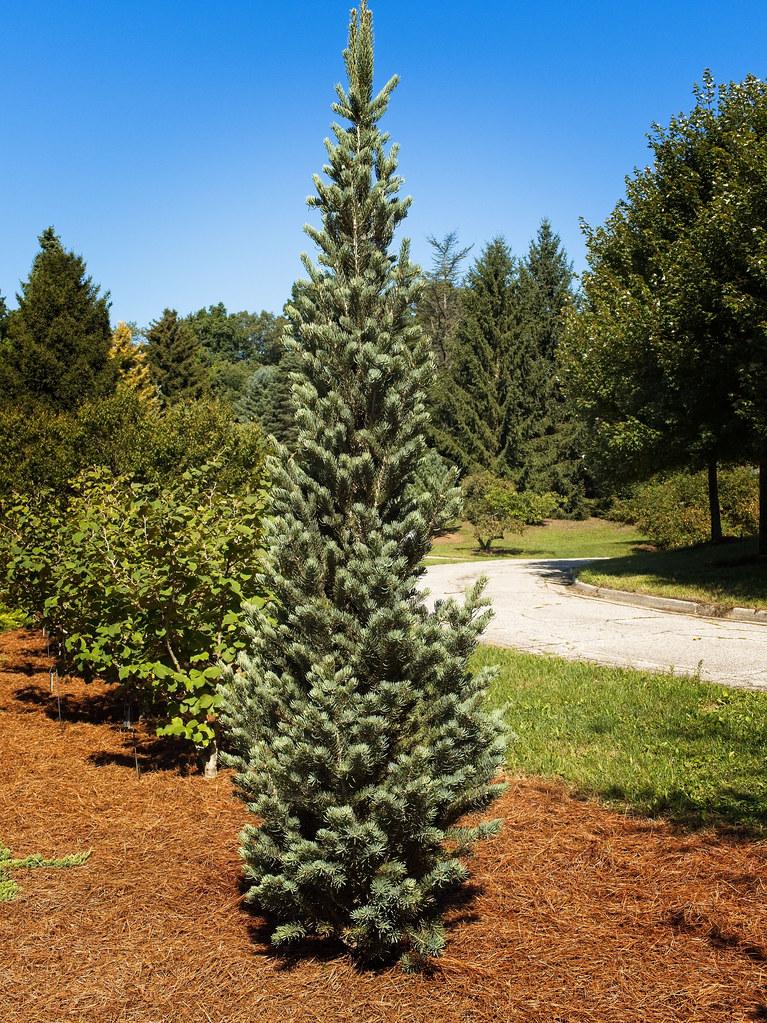

White Fir (Abies concolor)
Also known as: Abies concolor, Silver Fir, Concolor Fir, Colorado Fir.
White Fir (Abies concolor) is an evergreen tree species found in the western United States. It has a distinct white bark that fades to a yellowish hue on the lower branches and a graceful, conical shape. The beautiful Blue-green needles of White Fir are soft and tufted at the end and release a pleasant Christmas-like aroma when crushed. This sturdy species can grow up to 300 feet tall and over 140 years old, making it one of the longest living species in the world. It is highly adaptable, drought-tolerant, and very low maintenance with minimal pruning requirements. White Fir is an excellent choice for privacy screens, windbreaks, and living Christmas trees.
Interesting facts about the White Fir:
- Wide Geographic Range: The White Fir has a notably broad natural range compared to other fir species. It is native to the mountains of western North America, from the Rocky Mountains to the West Coast. This wide distribution is unusual for firs, which typically have more limited ranges.
- Distinctive Needle Characteristics: One of the most distinguishing features of the White Fir is its needles. They are unusually long for a fir, reaching up to 3 inches, and are uniquely flexible and soft to the touch. This feature makes the tree particularly attractive in landscaping and as a Christmas tree, as it is less prickly than other firs.
- Tolerance to Drought and Heat: White Firs are exceptionally tolerant of drought and heat, more so than many other fir species. This makes them well-suited to the varied and often challenging climates of the American West, where other conifers might struggle.
- Longevity and Growth: The White Fir can live for several centuries, with some specimens known to be over 300 years old. It grows relatively slowly but can reach impressive heights, often towering over 150 feet tall in its natural habitat.
- Variation in Color: The common name “White Fir” comes from the color of its bark and wood, which is a pale gray or white, unlike the darker bark typical of many conifers. The tree’s needles also have a bluish-green hue, which can vary in intensity depending on the specific environment and genetics of the tree.
- Wildlife Habitat: The White Fir plays a crucial role in its ecosystem, providing habitat and food for a variety of wildlife. Its seeds are a food source for birds and small mammals, and its dense foliage offers shelter. The tree’s health is essential for the wellbeing of these species.
- Use in Traditional Medicine: Native American tribes have traditionally used the White Fir for medicinal purposes. The resin was used for treating burns, cuts, and respiratory ailments, while the needles were used in herbal teas as a remedy for colds and stomachaches.
Plant care guide:
Sunlight
White Fir (Abies Concolor) requires a minimum of 6 hours of direct sunlight per day in order to grow and thrive. It prefers full sun, but it can also tolerate partial shade. The best time for White Fir to receive sunlight is between 10am and 2pm, when the sun is at its strongest. During the late afternoon and early morning, the sun's rays may be too weak for the tree to absorb. If the tree is not receiving enough sunlight, it may become stunted or develop yellowing needles.
Watering
White Fir (Abies Concolor) should be watered thoroughly once per week during the growing season. During the winter, water should be reduced to once every two weeks. The soil should be moist but not soggy, so it is important to adjust the amount of water as needed. If the soil around your White Fir becomes too wet, it is important to aerate the soil by adding a bit of sand or stone to allow water to drain better. Firs can also suffer from over-watering, so be sure to check the soil before each watering and adjust accordingly. When in doubt, less water is better than too much when it comes to White Firs.
Pruning
Pruning white fir Abies concolor should be done regularly to keep the tree healthy and promote new growth. Pruning should be done in late winter or early spring before new growth emerges. Make sure to remove any dead, diseased, or damaged branches at this time. Pruning should be light, removing no more than 1/3 of the tree’s total foliage. Make sure to leave enough foliage to maintain the natural shape of the tree. Pruning can be done with hand shears or pruning saws.
Plant information:
- Family: Pinaceae
- Type: Tree
- Height: ~13.72 meters
- Cycle: Perennial
- Growth Rate: Low
-
Anatomy:
- Leaves: silver-green, silvery-green
- Branches: silver, green-brown, silver-brown
- Needles: silvery-green
- Stem: brown
- Flower Color: Non-flowering
- Maintenance: Moderate
- Care Level: Moderate
-
Watering:
- Average
- Every 7-10 days
- Sunlight requirement: Full sun, part shade
- Pruning:
- February, March, April
- Propagation: Seed Propagation, Hardwood Cuttings
- Pest Susceptibility: Aphids, Adelgids, Canker, Sap rot, Dieback, Root rot, Pest resistant, Disease resistant
- Soil: Acidic, Rocky , gravelly , dry, Well-drained
- Origin: Western United States, Mexico
- Seeds: No
- Drought Tolerant: Yes
- Salt Tolerant: No
- Thorny: No
- Invasive: No
- Tropical: No
- Indoor: No
- Flowers: Yes
- Cones: Yes
- Fruits: No
- Edible Fruit: No
- Leaf: Yes
- Edible Leaf: No
- Cuisine: No
- Medicinal: Yes
- Poisonous to Humans: No
- Poisonous to Pets: No

Sources & more information:
Content is based on public databases such as the KEW Plants of the World database, among others. Please double-check all information. "About Plants" does not take responsibility for any inaccuracies.
